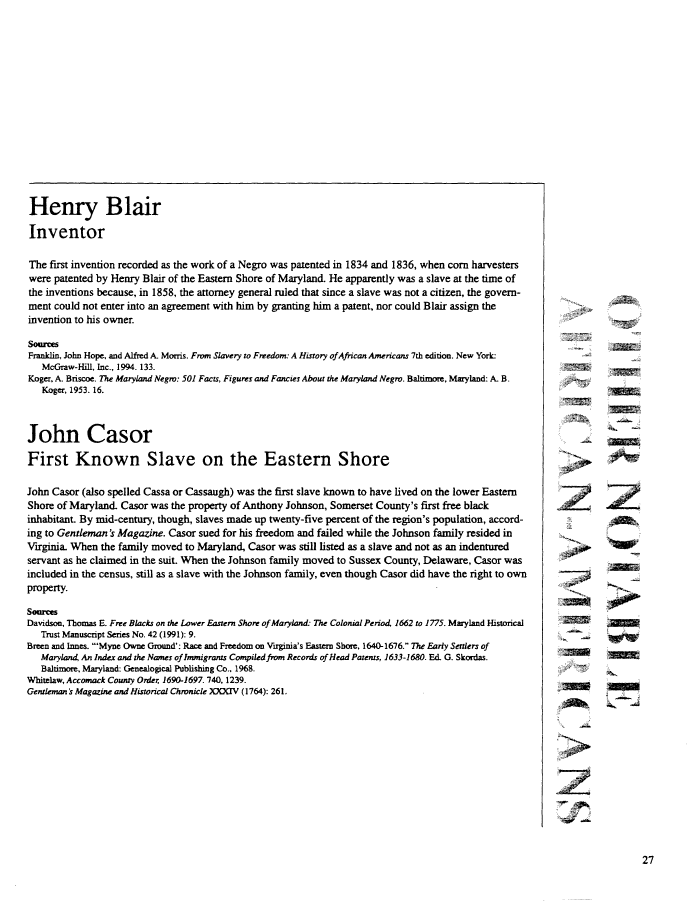 |
||||
|
TASK FORCE TO STUDY THE HISTORY AND LEGACY OF SLAVERY IN MARYLAND (Final Report) 1999/12/31 MdHR 991422 MdHR 991422, Image No: 387 Print image (70K) |
 |
||||
|
TASK FORCE TO STUDY THE HISTORY AND LEGACY OF SLAVERY IN MARYLAND (Final Report) 1999/12/31 MdHR 991422 MdHR 991422, Image No: 387 Print image (70K) |
| Henry Blair Inventor The first invention recorded as the work of a Negro was patented in 1834 and 1836, when corn harvesters were patented by Henry Blair of the Eastern Shore of Maryland. He apparently was a slave at the time of the inventions because, in 1858, the attorney general ruled that since a slave was not a citizen, the government could not enter into an agreement with him by granting him a patent, nor could Blair assign the invention to his owner. Sources Franklin, John Hope, and Alfred A. Morris. From Slavery to Freedom: A History of African Americans 7th edition. New York: McGraw-Hill, Inc., 1994. 133. Koger, A. Briscoe. The Maryland Negro: 501 Facts, Figures and Fancies About the Maryland Negro. Baltimore, Maryland: A. B. Koger, 1953. 16. John Casor First Known Slave on the Eastern Shore John Casor (also spelled Cassa or Cassaugh) was the first slave known to have lived on the lower Eastern Shore of Maryland. Casor was the property of Anthony Johnson, Somerset County's first free black inhabitant. By mid-century, though, slaves made up twenty-five percent of the region's population, according to Gentleman's Magazine. Casor sued for his freedom and failed while the Johnson family resided in Virginia. When the family moved to Maryland, Casor was still listed as a slave and not as an indentured servant as he claimed in the suit. When the Johnson family moved to Sussex County, Delaware, Casor was included in the census, still as a slave with the Johnson family, even though Casor did have the right to own property. Sources Davidson, Thomas E. Free Blacks on the Lower Eastern Shore of Maryland: The Colonial Period, 1662 to 1775. Maryland Historical Trust Manuscript Series No. 42 (1991): 9. Breen and Innes. "'Myne Owne Ground': Race and Freedom on Virginia's Eastern Shore, 1640-1676." The Eariy Settlers of Maryland, An Index and the Names of Immigrants Compiled from Records of Head Patents, 1633-1680. Ed. G. Skordas. Baltimore, Maryland: Genealogical Publishing Co., 1968. Whitekw.Accomodt County Order, 1690-1697. 740, 1239. Gentleman's Magazine and Historical Chronicle XXXTV (1764): 261. ^^._ ;: **»», 27 |